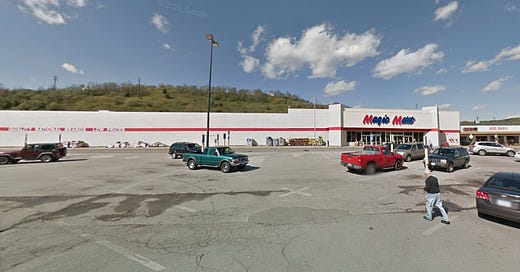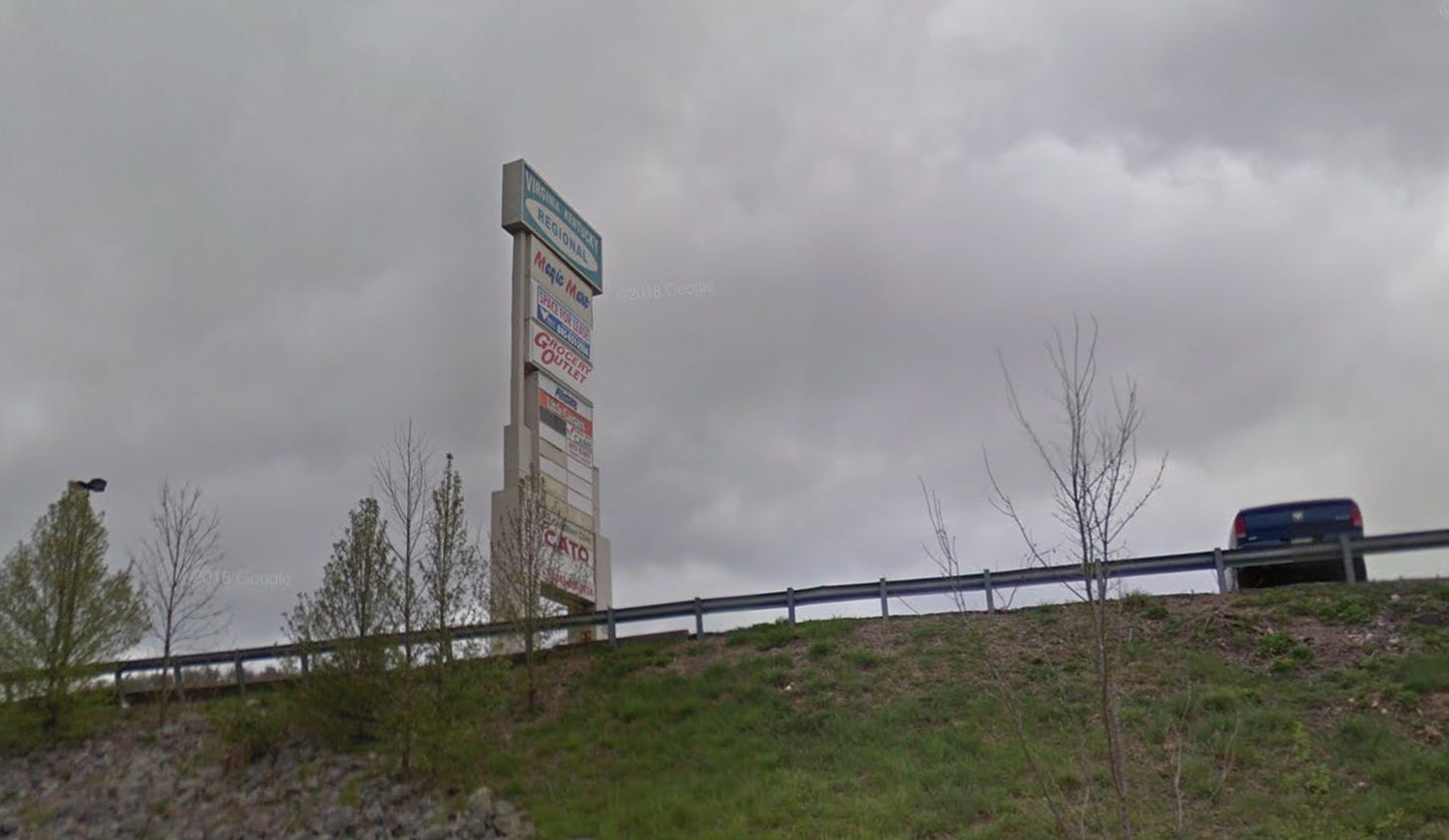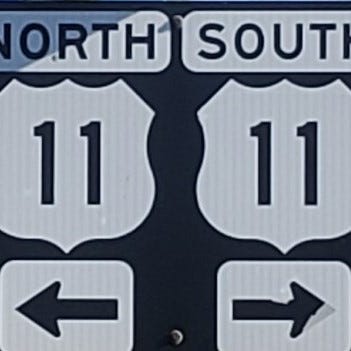I’m always interested when urbanist issues intersect with retail. In some ways, that was a background issue in my recent writing about a Maryland thrift store (first here for Strong Towns, and here the other day.)
I don’t need to rehash that whole story here—either link will give you a sense of it, if it interests you—but the relevant bit here is that the current thrift store used to be an Ames. Ames was basically K-Mart: a discount department store, somewhere between a dollar store or variety store on the one hand, and a Walmart on the other.
This retail segment is really interesting. As a concept, it pretty much evolved out of the dime store/variety store (and in some ways the contemporary dollar store is a re-evolution of that old ancestor of the discount department store).
As for the discount department store itself, that segment consists mostly of Target and Walmart today. But it was once a huge segment with dozens of national, regional, and local chains. I wrote in yesterday’s post:
As far as finding a close replacement for the Ames, such stores—larger than a dollar store, smaller than a Walmart—effectively no longer exist. There were once dozens of such chains, some closer to the variety or five-and-dime store and some closer to a “full-line” discount department store like Walmart. Ames, Jamesway, Caldor, Woolworth, Bradlees, Laneco, many more—these stores died out rapidly in the 1990s and early 2000s, for reasons far above anything a zoning board can affect. K-Mart is one of the last surviving incarnations of the discount department store at this smaller-than-Walmart scale.
You could add to that list Two Guys, Zayre, and many more. Roses Discount Stores is one of a handful of surviving regional chains in this older style.
That’s a bit of a long introduction, but this piece is related to all of this.
Whenever my wife and I drive far away from the D.C. area—out west in Maryland, or the Eastern Shore, or the expanses of central or southern Virginia—we always notice the shift in retail. You’ll see a lot of the same forms: little downtowns, strip plazas, freestanding big-box stores, occasional indoor malls. But a lot of the stores we take for granted are just completely absent. I’ve never lived more than 25 minutes from a premium indoor mall, or multiple strip plazas with a large choice of supermarkets, clothing stores, and anything else you’d want.
But out here, you have fewer choices. Some of that is just low population density or lower average incomes. But sometimes I come across shopping centers that obviously were once hopping, and it looks like things have gotten worse in just the relatively short time since they were built. Where do people go shopping out there? Well, places like this.
I recently found on Google Maps this large shopping center in southwestern Virginia, the poorest part of the state, and one of the most remote. Specifically, this is in Norton (it’s closer to Nashville, Tennessee than to Washington, D.C.) This shopping center was anchored by a now-defunct regional discount department store chain, Magic Mart. The Magic Mart was in a former Walmart space. This is one of the older Walmart designs, abandoned in large numbers as the company added more and more Supercenters.
From some pictures I could find, and based on its locations, Magic Mart was a lot like Ames. (Here are a few articles about its 2018 demise.) They were smaller than Walmart, generally, maybe slightly more downscale, and tended to be located in rural or small-town settings. They basically went where the largest chains didn’t. But when those larger chains, i.e. Target and especially Walmart expanded and drove them out of business in the 1990s and early 2000s, nothing quite replaced them. Maybe dollar stores. Maybe Amazon, just like Sears more than a century ago. But not quite.
If you look at Google Images results for Magic Mart, you’ll see that they appear to mostly occupy pre-existing buildings, meaning many stores of this size had come and gone even in these remote areas. Magic Mart goes back to 1920, but in its modern Walmart-like incarnation, it dates to 1991. It operated 16 stores in five states—a scale that has been increasingly squeezed out. Here’s its Wikipedia page.
Much of the strip plaza is, or at least recently was, vacant. Take a look at the sign, pictured on Google Maps. I don’t know how much this reflects general economic distress, poor business decisions on the part of the builder or leasing company, or just a general overbuilding of physical retail. But it’s sad to see this. In my experience, much of rural America looks like this in terms of shopping options. (The other anchor is a discount grocery store.) It’s only sad, but kind of eerie. These partially or even largely empty shopping centers are American ruins.
To be honest, this is a largely unfamiliar world to me. The sorts of things I take for granted when I go shopping for groceries or other things just aren’t really available. You want a Sleep Number bed? Want clothing at Ann Taylor or Aeropostale or Uniqlo? A USDA Prime ribeye? Korean or Chinese groceries? Sushi-grade yellowfin tuna or Norwegian salmon? That’s all a 15 minute drive from my home. Some of that stuff is 30, 40, 50 miles away or more out here.
Because I’ve lived in places where these sorts of things are common, it can be hard to grasp how uncommon they are, geographically anyway. One of the reasons I love driving around and exploring places is because it reminds me that my everyday experience is far from representative of the whole country. I think it’s important to remember that, and very easy to forget it.
Now, as noted, that Magic Mart closed in 2018. What replaced it was intriguing to me. It’s now a Rural King, a sort of cross between a hardware store and a farm store—basically similar to Tractor Supply Co. Years ago, I noticed that two somewhat distressed rural-exurban New Jersey shopping centers, both once anchored by Ames, were now anchored by Tractor Supply Co. And this, here in a rural corner of Virginia, is basically the same thing.
I’m not sure exactly what it indicates, but the replacement of discount department stores with outdoor/farm stores is interesting. It says something, perhaps, about the reversion of some areas from exurban back to truly rural. (Although, with remote or hybrid work expanding commutable distances, a lot of countryside may end up turning into the far reaches of metro exurbs.) It also indicates, as noted above, that nothing has really replaced those mid-sized discount stores (dollar stores fill a similar niche, but are in most ways inferior.)
And when you look at these huge shopping centers, some, like this one in Norton anchored by national chains, way out in sparse, rural areas, you wonder how they ended up there and why they left. Did the places change, or the stores’ business models, or both?
Anybody here who lives in rural America, or with any more knowledge of retail trends than I have, I’d love to hear anything you have to say on any of this!
Related Reading:
Dollar Stores and Retail Evolution Revisited
Please consider upgrading to a paid subscription to help support this newsletter. You’ll get a weekend subscribers-only post, plus full access to the archive of nearly 300 posts and growing. And you’ll help ensure more material like this!







I have been to Norton and SW VA 2x in the last couple of years. Just down the road in Appalachia - probably one of the coolest places in VA - this former coal town/city had just lost its last grocery store. There was nothing left - right at the beginning of the pandemic. I have no idea how the remaining citizens survive, but I am curious about the impact of the disappearance of basic necessities. How much need to go before a town must be abandoned? What about the people who are trapped there with no means to leave?
It's interesting that Tractor Supply Co seems less affected by Amazon than more mainstream retail. Is that true, and if so, why?